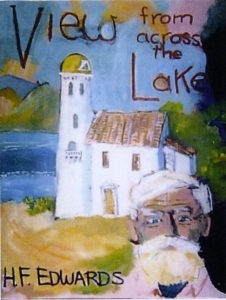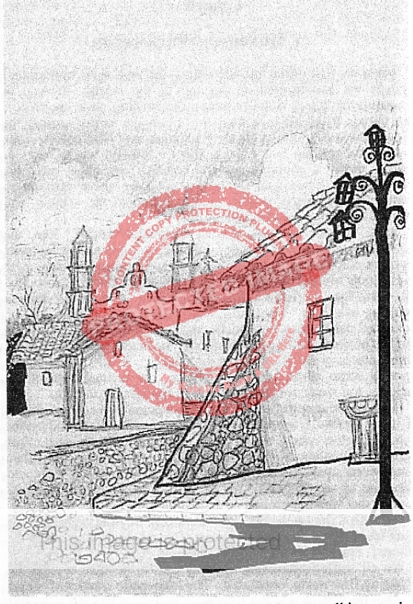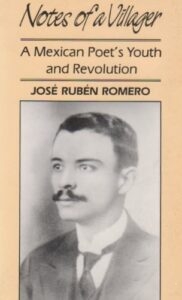Artist and author Henry F. Edwards lived in Ajijic, with his wife, Corinne, and their numerous children, for many years in the 1960s and 1970s.
Henry ‘Hank’ Edwards was born on 9 May 1933 and completed studies at the University of New Mexico; San Diego State University; and the University of California. He served in the Navy on the aircraft carrier USS Shangri-La and then worked for a decade in the space industry, as a scientist-engineer on advanced satellites. Having made profitable investments, he retired young to travel the world; the family lived in several different countries before settling at Lake Chapala for more than a decade, most of the time in Ajijic, and a much shorter time on the southern shore of the lake.

Edwards published and republished several books. The one most directly related to Ajijic is titled The Sweet Bird of Youth . This book, published in 2008, consists of two parts: “Fall of the Globo” and “Living the Lucky Life,” previously published in 1977 and 1997 respectively.
“Fall of the Globo” is a fictionalized memoir of his time in Ajijic. Ajijic is renamed Tzipan in the book, and Jocotepec becomes San Pedro, while Henry and Corinne become Harold and Colleen. The book is a roman à clef, where many of the characters are only thinly disguised. It includes stories about building the Edwards’ family home, nicknamed “El Castillo” because of its castle-like turret, a couple of blocks north of Seis Esquinas. They had previously rented a property at Independencia #41, where artist John K Peterson later lived for a time.
Parts of Playing Prince in a Palace (2009) also relate to the family’s time in Mexico, while The View from Across the Lake (originally published in 2002) is about life on the southern shore of the lake before they then decided to move to Guatemala.
Edwards also penned an article titled “On Lake Chapala” for the Lake Chapala Review, which offers a chatty account of what life in Ajijic was like when he and his family lived in the village. The illustration accompanying that article was drawn by Simón Velásquez, son of long-time village artists Enrique and Belva Velásquez.
What was Ajijic like when Hank Edwards was living there? Well, it was a lot smaller than it is today, as evidenced by this simplified sketch map drawn by Hank and included in The Sweet Bird of Youth:

Sketch map of Ajijic, c. 1970, by Henry F Edwards.
The ‘paved road’ is the current carretera, completed in the early 1950s, a decade before Edwards arrived in Ajijic. (A 1976 US newspaper quotes Edwards as planning to spend summers on San Juan Island, “and the winters in Ajijic where we have lived for the past eight years.”) The line labelled ‘End of Town’ on the map is especially instructive in that there was apparently very little construction north of the carretera, even in about 1960. The “Castillo” was on the edge of the town.
Edwards pursued his art interests while in Ajijic, and held a one man show of 36 oils, done over five years, at what was then the Jalisco state gallery in La Floresta.
Edwards exhibited in a group show in March 1976 at the “José Clemente Orozco Gallery” in Ajijic, a gallery directed by Dionicio Morales at a location three blocks from the plaza on Guadalupe Victoria. Other artists in that show included Jonathan Aparicio, Frank Barton, Antonio Cárdenas, Antonio López Vega, Dionicio Morales, Julian Pulido, Sid Schwartzman, and Havano Tadeo.
Hank and Corinne (Bush) Edwards co-starred as the leading couple in the farce “Here Lies Jeremy Troy” presented by the Lakeside Little Theater in April 1976 at the Chula Vista Country Club. Corinne had performed in Victoria, BC, Canada, and in several previous Lakeside Little Theater productions.
At the time of “”Here Lies Jeremy Troy,” Hank Edwards apparently sponsored the short-lived Wes Penn Gallery (named for the deceased artist ex-husband of author Jan Dunlap). The gallery was trying to organize a two-person exhibit of paintings by Peter Huf and his wife, Eunice Hunt Huf, who, after living in Ajijic for many years, had moved back to Germany. A short press comment adds that, “Hank Edwards and Corinne Bush plan to leave Ajijic at the end of April, at which time the Wes Penn Gallery will be managed by Cristina Rigby of Jocotepec.” Cristina Rigby, it is worth noting, was the wife of British Hollywood writer Ray Rigby (The Hill).

Henry Edwards. c 1970. Street scene.
Hank and Corinne left Ajijic in May 1976, after throwing a medieval costume party for Frank and Kathy Barton who had taken over “El Castillo,” but returned the following year, when Hank became an active member of the informal cultural group TLAC (Todas las Artes Combinadas).
At the end of the 1970s, Edwards and his wife moved back to the US, where they lived in Oregon and Arizona. Corinne died in about 2016. When I was last in touch with Henry, several years ago, he still owned an island in the middle of Lake Atitlan in Guatemala, an island where he and his wife had once hoped to build a castle . . .
Several chapters of Foreign Footprints in Ajijic: Decades of Change in a Mexican Village offer more details about the history of the artistic community in Ajijic.
Acknowledgments
My sincere thanks to both Alan Pattison and Henry Edwards for sharing their memories of Ajijic with me via phone, in July 2014 and November 2016 respectively.
Sources
- Henry F Edwards. 2008. The Sweet Bird of Youth (BookSurge)
- ___2009. Playing Prince in a Palace (BookSurge)
- ___2009. The View from Across the Lake (BookSurge)
- ___2007. “On Lake Chapala,” Lake Chapala Review, April 2007
- Guadalajara Reporter: 13 March 1976, 21; 3 April 1976, 31; 3 April 1976; 22 May 1976, 22; 16 Apr 1977, 19.
- The Islands Sounder: 10 Nov 1976, 19.
Comments, corrections or additional material related to any of the writers and artists featured in our series of mini-bios are welcomed. Please use the comments feature at the bottom of individual posts, or email us.
